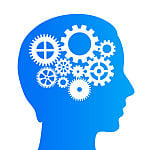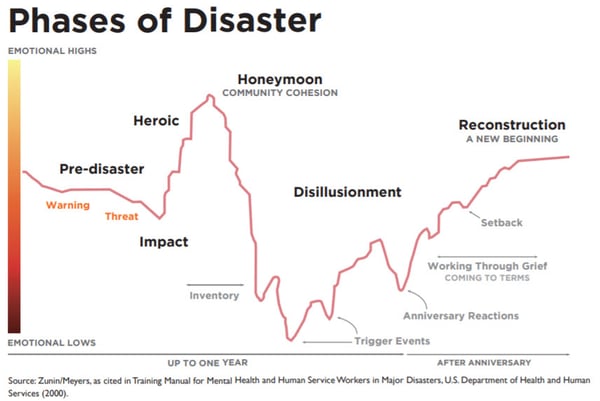 Did you know that your emotional responses to disaster have a known structure and a logical order you will find comforting?
Did you know that your emotional responses to disaster have a known structure and a logical order you will find comforting?
I knew about the symptoms of physician burnout, Kubler-Ross and her stages, even stages of quitting smoking, but until today I had never been introduced to Zunin and Myers and the 6 Stages of Normal Human Emotional Response to Disaster.
This is a fascinating progression and strikes true for my experience of COVID so far. These stages are intertwined with physician burnout, PTSD and so many other normal and abnormal psychological responses to difficulty and struggle.
============
Are You Prepared for the Great Practice RESET of 2022?
Get the Tools and Support to Take Back Your Practice
in the Wake of the Pandemic
============
If you are also new to this work, I encourage you to invest a few minutes here to learn more. I have asked several dozen doctors if they have heard of this work before. None have said yes.
If you are like me, you will recognize these stages in your own life and have a framework for understanding the emotional echos of disaster in yourself, your colleagues and patients going forward.
Let's look at the graph first and then run through the phases one-by-one.
Graph Source: Graph from Samsha.gov. adapted from Zunin and Myers
Phases of Disaster https://www.samhsa.gov/dtac/recovering-disasters/phases-disaster
Zunin and Myers' Six Stages
As you read through the descriptions below, I encourage you to notice your personal response to the disasters of 2020 and your current location in this progression.
As you notice disaster impact on colleagues and patients going forward, you will be able to locate them in the progression and orient them to the normal feelings in that stage.
Note:
-
-
-
- The time frame for progression through the stages is highly variable.
- Stages can be skipped
- This is a NORMAL RESPONSE to disaster. We are not talking about psychopathology here.
-
-
Pre-Disaster/Warning/Threat
Sometimes a disaster gives you a warning and you brace yourself for impact. Sometimes it comes out of the blue. Hard to say which is worse.
If you had a warning and failed to prepare, subsequent guilt and self-blame can be severe. If you were hit with no warning it can cause feelings of vulnerability to future unpredicted tragedy.
Impact
WHAM ... shock, panic, disbelief, confusion ... often followed by self-preservation and circling the wagons to protect your loved ones.
Heroic
Adrenaline induced rescue behavior, feelings of clarity, expressions of strength and cooperation in response to disaster impact. Survivors can put themselves at great risk in their rescue activities. This phase can include reunion with family members and even pets who were separated from you.
Honeymoon
There comes a time where you can wrap your brain around the impact of the disaster and the immediate risk of injury/death has passed. Emergency personnel and support are now widely available. Community/survivor bonding occurs. Optimism and relief break out.
Focus is on food, clothing, shelter and the full impact of the disaster starts to settle in around the edges.
Disillusionment
Impact sinks in deeply. The inability of disaster response to make you whole again becomes obvious. Discouragement, fatigue, exhaustion. Support services, volunteers, acute disaster resources and media begin to pull out, leaving survivors feeling abandoned and resentful. Layers of impact become apparent: physical, economic, housing, family discord, bureaucratic hassles with disaster relief, lack of leisure or recreation breaks all take a toll.
Surrounding communities that are unaffected return to business as usual causing discouragement and and alienation in survivors. Unequal disaster relief rewards can cause conflict between survivors. Inadequate disaster response can produce extreme outrage and long lasting resentment.
Reconstruction/Recovery
Survivors realize they must take responsibility for rebuilding and problem solving. Grief, recognition of personal strengths, re-examination of life priorities all occur. Some will feel renewed empowerment, a light at the end of the tunnel and begin to put the disaster behind them.
Others will experience deep levels of dysfunction in their personal, family and work life. This is often where disaster-related psychopathology can begin to appear.
This phase is punctuated with trigger events, anniversary reactions and other setbacks. It may help to take another look at the graph above.
GO DEEPER:
If you are intrigued by this work and want to dive in, I strongly recommend the following reference text. You will see the Zunin and Myers' Phases explained in their original context in Module 4 "Reactions to Disasters: The Human Response" - starting on page 51. Full PDF Download is available at the link:
Disaster Mental Health a Critical Response: A training curriculum for mental health and spiritual care professionals in healthcare settings. University of Rochester and NYState Department of Health and Office of Mental Health, 2006
https://www.urmc.rochester.edu/MediaLibraries/URMCMedia/flrtc/preparedness-response-tools/documents/H_DMH_Part_Manual.pdf
============
PLEASE LEAVE A COMMENT
- Have you heard of this six phase model before?
- Do you find these phases familiar and useful?
- Where are you and your community in the COVID-19 Disaster response here in 2020?

